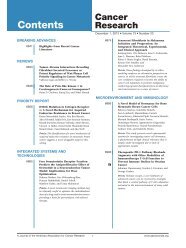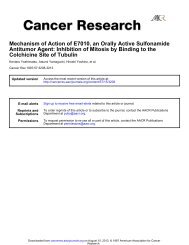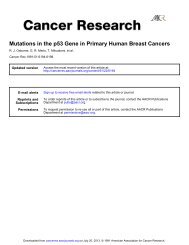XANTHOMA OF THE BREAST In a series of nine hundred (circa ...
XANTHOMA OF THE BREAST In a series of nine hundred (circa ...
XANTHOMA OF THE BREAST In a series of nine hundred (circa ...
You also want an ePaper? Increase the reach of your titles
YUMPU automatically turns print PDFs into web optimized ePapers that Google loves.
Downloaded from cancerres.aacrjournals.org on December 28, 2013. © 1932<br />
American Association for Cancer Research.<br />
<strong>XANTHOMA</strong> <strong>OF</strong> <strong>THE</strong> <strong>BREAST</strong> 1079<br />
citron-yellow to saffron or brown, are symmetrically situated<br />
on or about the eyelids. They develop slowly, usually in middle<br />
age or old age. and persist throughout life.<br />
(2) Xanthoma multiplex: Under this designation are grouped<br />
those less frequent cases with multiple xanthoma nodules situated<br />
most frequently on the scalp, knees, elbows, buttocks, or fingers.<br />
It is noteworthy that these regions are those most exposed to<br />
trauma. The mucous membranes, particularly the cornea and<br />
buccal mucosa, may also be involved. The distribution <strong>of</strong>ten<br />
follows the folds <strong>of</strong> the skin and is usually symmetrical. Autopsy<br />
in these cases may show xanthoma nodules in any <strong>of</strong> the viscera,<br />
but particularly in the liver, spleen, and meninges. <strong>In</strong> a considerable<br />
percentage <strong>of</strong> cases disease <strong>of</strong> the liver, such as cirrhosis or<br />
some type <strong>of</strong> toxic or infectious hepatitis, is found. Sikemeier<br />
collected a <strong>series</strong> <strong>of</strong> cases <strong>of</strong> this type and reported one in which<br />
the liver was the seat <strong>of</strong> localized tuberculosis.<br />
Most <strong>of</strong> the recently reported cases <strong>of</strong> xanthoma multiplex<br />
have included blood analyses, which showed an elevated blood<br />
cholesterin. Richter (Case 1) described a case <strong>of</strong> this type in<br />
which the blood cholesterin on admission was 650 mg. per cent.<br />
After the patient had been on a cholesterin-free diet for six weeks<br />
the blood cholesterin had fallen to 281 mg. per cent and the xanthoma<br />
nodules had become s<strong>of</strong>ter and smaller. Although the<br />
blood cholesterin has generally been found to be elevated, there are<br />
reports <strong>of</strong> isolated cases, such as those described by Siemens and by<br />
Rosenbloom, in which it remained within normal limits. Schmidt<br />
has emphasized that the hypercholesterinemia may be intermittent,<br />
and that repeated determinations are therefore necessary.<br />
Chalipsky and Veger have called attention to a group <strong>of</strong> cases<br />
in which xanthoma multiplex occurs in association with hypogenitalism<br />
and disturbed ovarian function. They describe one<br />
such case which they observed.<br />
<strong>In</strong> a small group <strong>of</strong> cases xanthoma seems to be familial. This<br />
type <strong>of</strong> the disease has the same anatomic distribution as xanthoma<br />
multiplex except that the eyelids do not seem to be involved. The<br />
lesions may be congenital or may appear at any time before<br />
puberty. There is no evidence <strong>of</strong> associated liver disease. Mackenzie<br />
and Startin described two families in each <strong>of</strong> which there<br />
were several members affected by the disease. Arning and Lippmann<br />
observed xanthomatosis in a mother and in five <strong>of</strong> her <strong>nine</strong><br />
children. Hufschmitt and Nessmann have recently reported a
















